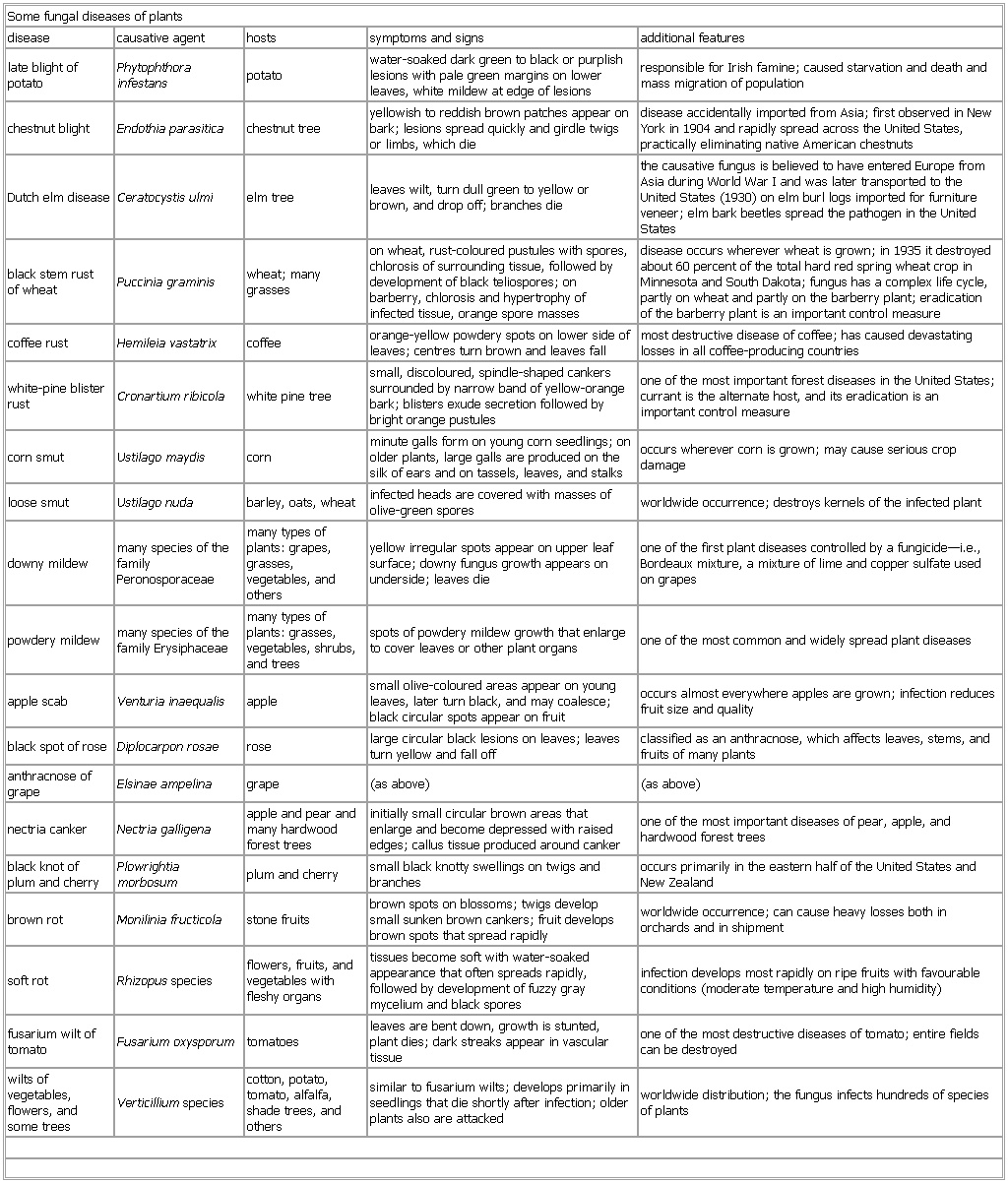Some fungal diseases of plants
Table
Some fungal diseases of plants
disease causative agent hosts symptoms and signs additional features
late blight of potato Phytophthora infestans potato water-soaked dark green to black or purplish lesions with pale green margins on lower leaves, white mildew at edge of lesions responsible for Irish famine; caused starvation and death and mass migration of population
chestnut blight Endothia parasitica chestnut tree yellowish to reddish brown patches appear on bark; lesions spread quickly and girdle twigs or limbs, which die disease accidentally imported from Asia; first observed in New York in 1904 and rapidly spread across the United States, practically eliminating native American chestnuts
Dutch elm disease Ceratocystis ulmi elm tree leaves wilt, turn dull green to yellow or brown, and drop off; branches die the causative fungus is believed to have entered Europe from Asia during World War I and was later transported to the United States (1930) on elm burl logs imported for furniture veneer; elm bark beetles spread the pathogen in the United States
black stem rust of wheat Puccinia graminis wheat; many grasses on wheat, rust-coloured pustules with spores, chlorosis of surrounding tissue, followed by development of black teliospores; on barberry, chlorosis and hypertrophy of infected tissue, orange spore masses disease occurs wherever wheat is grown; in 1935 it destroyed about 60 percent of the total hard red spring wheat crop in Minnesota and South Dakota; fungus has a complex life cycle, partly on wheat and partly on the barberry plant; eradication of the barberry plant is an important control measure
coffee rust Hemileia vastatrix coffee orange-yellow powdery spots on lower side of leaves; centres turn brown and leaves fall most destructive disease of coffee; has caused devastating losses in all coffee-producing countries
white-pine blister rust Cronartium ribicola white pine tree small, discoloured, spindle-shaped cankers surrounded by narrow band of yellow-orange bark; blisters exude secretion followed by bright orange pustules one of the most important forest diseases in the United States; currant is the alternate host, and its eradication is an important control measure
corn smut Ustilago maydis corn minute galls form on young corn seedlings; on older plants, large galls are produced on the silk of ears and on tassels, leaves, and stalks occurs wherever corn is grown; may cause serious crop damage
loose smut Ustilago nuda barley, oats, wheat infected heads are covered with masses of olive-green spores worldwide occurrence; destroys kernels of the infected plant
downy mildew many species of the family Peronosporaceae many types of plants: grapes, grasses, vegetables, and others yellow irregular spots appear on upper leaf surface; downy fungus growth appears on underside; leaves die one of the first plant diseases controlled by a fungicide—i.e., Bordeaux mixture, a mixture of lime and copper sulfate used on grapes
powdery mildew many species of the family Erysiphaceae many types of plants: grasses, vegetables, shrubs, and trees spots of powdery mildew growth that enlarge to cover leaves or other plant organs one of the most common and widely spread plant diseases
apple scab Venturia inaequalis apple small olive-coloured areas appear on young leaves, later turn black, and may coalesce; black circular spots appear on fruit occurs almost everywhere apples are grown; infection reduces fruit size and quality
black spot of rose Diplocarpon rosae rose large circular black lesions on leaves; leaves turn yellow and fall off classified as an anthracnose, which affects leaves, stems, and fruits of many plants
anthracnose of grape Elsinae ampelina grape (as above) (as above)
nectria canker Nectria galligena apple and pear and many hardwood forest trees initially small circular brown areas that enlarge and become depressed with raised edges; callus tissue produced around canker one of the most important diseases of pear, apple, and hardwood forest trees
black knot of plum and cherry Plowrightia morbosum plum and cherry small black knotty swellings on twigs and branches occurs primarily in the eastern half of the United States and New Zealand
brown rot Monilinia fructicola stone fruits brown spots on blossoms; twigs develop small sunken brown cankers; fruit develops brown spots that spread rapidly worldwide occurrence; can cause heavy losses both in orchards and in shipment
soft rot Rhizopus species flowers, fruits, and vegetables with fleshy organs tissues become soft with water-soaked appearance that often spreads rapidly, followed by development of fuzzy gray mycelium and black spores infection develops most rapidly on ripe fruits with favourable conditions (moderate temperature and high humidity)
fusarium wilt of tomato Fusarium oxysporum tomatoes leaves are bent down, growth is stunted, plant dies; dark streaks appear in vascular tissue one of the most destructive diseases of tomato; entire fields can be destroyed
wilts of vegetables, flowers, and some trees Verticillium species cotton, potato, tomato, alfalfa, shade trees, and others similar to fusarium wilts; develops primarily in seedlings that die shortly after infection; older plants also are attacked worldwide distribution; the fungus infects hundreds of species of plants
See as table:

- Hidatsa
- hiddenite
- hide
- hide-and-seek
- Hideyo Noguchi
- Hielm, Jonas Anton
- Hien Vuong
- Hierakonpolis
- Hierapolis
- hieratic script
- Hierocles Of Alexandria
- hieroglyph
- hieroglyphic writing
- Hieron I
- Hieron II
- Hieronymus Bock
- Hieronymus Emser
- Hieronymus Fabricius ab Aquapendente
- hierophant
- hieros gamos
- Hierta, Lars Johan
- Higashikuni Naruhiko
- Higashi-Murayama
- Higashi-Ōsaka
- Higden, Ranulf